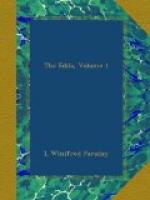(4) In Voeluspa the Sibyl prophesies, “I saw doom threatening Baldr, the bleeding victim, the son of Odin. Grown high above the meadows stood the mistletoe, slender and fair. From this stem, which looked so slender, grew a fatal and dangerous shaft. Hoed shot it, and Frigg wept in Fenhall over Valhall’s woe.” The following lines, on the chaining of Loki, suggest his complicity.
(5) Hyndluljod has one reference: “There were eleven Aesir by number when Baldr went down into the howe. Vali was his avenger and slew his brother’s slayer.”
Besides these there is a fragment quoted by Snorri: “Thoekk will weep dry tears at Baldr’s funeral pyre. I had no good of the old man’s son alive or dead; let Hel keep what she has.” Grimnismal assigns a hall to Baldr among the Gods.
There are, in addition, two prose versions of the story by later writers: the Icelandic version of Snorri (1178-1241) with all the details familiar to every one; and the Latin one of the Dane Saxo Grammaticus (about thirty years earlier), which makes Baldr and Hoed heroes instead of Gods, and completely alters the character of the legend by making a rivalry for Nanna’s favour the centre of the plot and cause of the catastrophe. On the Eddic version and on Saxo’s depend the theories of Golther, Detter, Niedner and other German scholars on the one hand, and Dr. Frazer on the other.
It has often been pointed out that there is no trace of Baldr-worship in other Germanic nations, nor in any of the Icelandic sagas except the late Frithjofssaga. This, however, is true of other Gods, notably of Tyr, who is without question one of the oldest. The only deities named with any suggestion of sacrifice or worship in the Icelandic sagas proper are Odin, Thor, Frey, Njoerd, Frigg and Freyja. The process of choice is as arbitrary in mythology as in other sciences. Again, it is more likely that the original version of the legend should have survived in Iceland than in Denmark, which, being on the mainland, was earlier subject to Christian and Romantic influences; and that a heathen God should, in the two or three centuries following the establishment of Christianity in the North, be turned into a mortal hero, than that the reverse process should have acted at a sufficiently late date to permit of both versions existing side by side in the thirteenth century. A similar gradual elimination of the supernatural may be found in the history of the Volsung myth. Snorri’s version is merely an amplification of that in the Elder Edda, which, scanty as its account of Baldr is, leaves no doubt as to his divinity.




